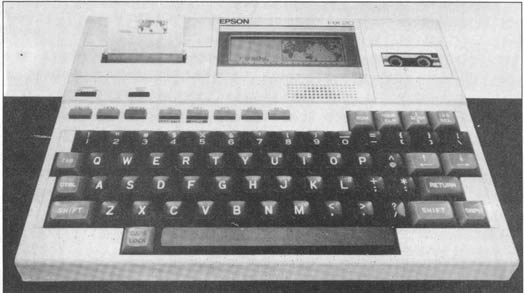There are no similar machines currently on the market, the closest being the 24lb. mains- powered Osborne 1, or the rather different New- Brain which in its battery- powered version will give little more than four hours con- tinuous operation. The Epson can run independently of mains power for 50 hours using its built-in NiCad cells, re- quiring about eight hours to then recharge fully. The whole package is very compact, while the keyboard is of good quality and feel and has the conventional QWER- TY typewriter-style layout and key spacing. As well as extra programmable function keys and the usual control keys, a numeric keypad has been pro- vided in a novel and space- saving way. The keys U, I, 0, J, K, L, and M, which lie directly under the 7, 8 and 9 keys, operate as number keys 0 to 6 when a special Number Shift key is locked down. A Graphic Shift key provides a further 32 graphic.characters. The screen, or more accur- ately the liquid-crystal display, is immediately above the keyboard and shows four lines of 20 characters using a five- by-seven dot font, or 120-by- 32 dot graphics. It can scroll sideways to show lines up to 255 characters long. The

LCDs used are the very latest
from Epson, which is a major
LCD supplier to the world
market. A knurled wheel at
the side of the case allows the
viewing angle to be adjusted
so that the LCDs are aimed
straight at you. The built-in
inked-ribbon matrix printer
prints graphics and upper- or
lower-case characters with de-
scenders on to plain paper
rolls. The mechanism is the
same as that supplied by
Epson for the inexpensive
Amber 2400 printer.
The space to the right of the
screen can be occupied by
either a microcassette drive for
program or data storage or a
plug-in ROM cartridge. The
system comes with 32K of
ROM, containing Microsoft
Basic and the operating sys-
tem, and 16K of RAM. An
optional expansion unit which
clips on the side of the case can
hold an extra 16K of RAM
and 32K of ROM.
The problem Epson had to
A second serial interface can be linked to floppy discs, a colour TV, or other computers in a local area network. Flop- pies for the HX-20 should be available at the time of launch.
A cassette interface is pro- vided so that an ordinary domestic cassette recorder can be used for program or data storage, instead of the option- al microcassette drive.
About a dozen applications will be available at the time of launch, including a VisiCalc look-a-like, word processor, mailing list, card-index type Database, Diary, and simple sales and purchase ledgers.
Epson (V.K.), Dorland House; 388 High Road, Wem- bley, Middlesex HA9 6UH. Telephone: 01-900 0466.